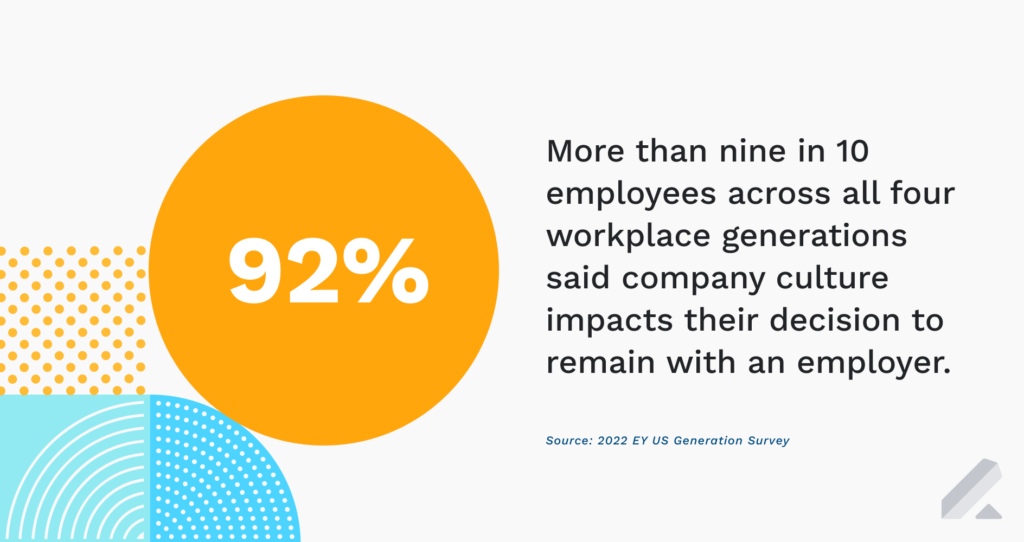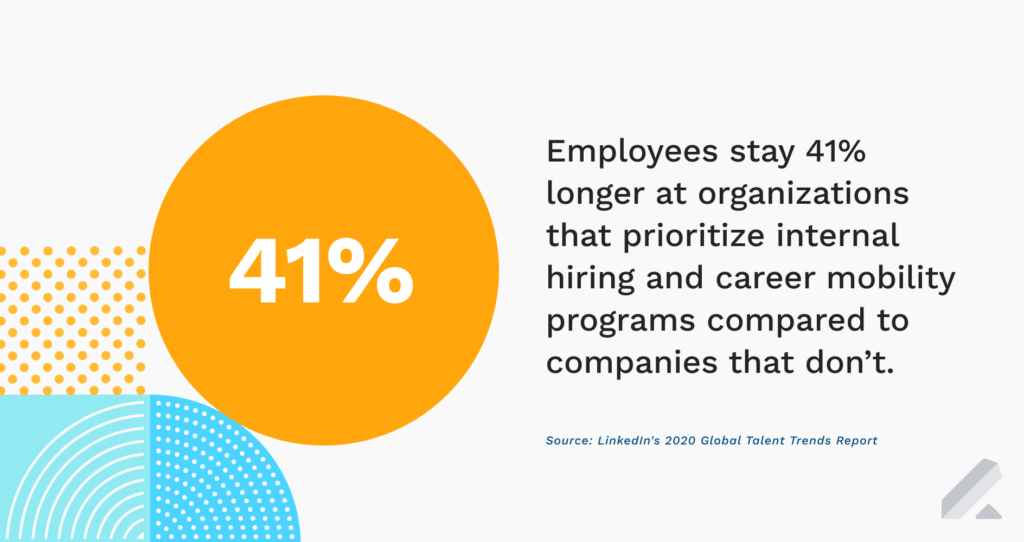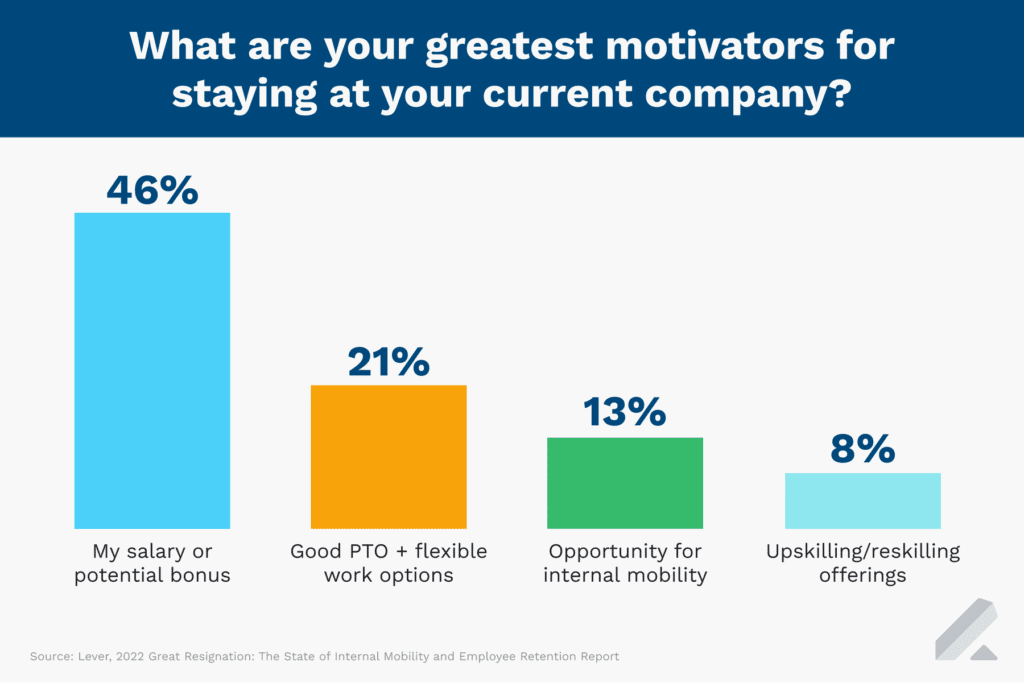Recent Employee Benefit News research found the average cost of losing an employee is 33% of their salary. You read right: One-third of a worker’s earnings go out the window when they pack up their desk. (Well, proverbial desk, if they work from home. You get the point.)
A high workforce turnover rate can wreak havoc on the balance sheets.
That said, the impact extends beyond just financial loss. It can also lead to low morale and employee engagement and, thereby, worsening workforce productivity and efficiency.
That makes prioritization of employee retention all the more important for orgs today.

Why employee retention matters
It’s not like we need to make the case to to implement an employee retention strategy to retain employees long term. However, it never hurts to revisit the negative ramifications of failing to focus on retaining high-performing members of your workforce.
Three notable ones include:
- 1) Employees who leave due to poor facets of your company that have been ignored or deprioritized too often (e.g., sparse chats with managers to discuss job satisfaction and training and development options, no flexible work or remote work options) are likely to share these reasons for leaving in online business reviews and/or word-of-mouth with their networks. This impacts your ability to attract net-new talent.
- 2) Backfilled roles can add up quickly, when there’s no dedicated employee retention strategy in place. This can lead to more work being added onto the plates of staff members who stay — workloads that could cause them to rethink their thoughts on your company as well.
- 3) Your talent acquisition team is constantly forced to source new prospects and ensure their job postings generate a sizable number of applications from external candidates simply to fill recently vacated roles. This is already on top of their efforts to fill newly created positions at your org, which is an already-laborious task in and of itself.
Conversely, there are several benefits of creating an employee retention action plan:
- Cost savings: Replacing an employee can cost a significant amount, from recruitment expenses to training costs. Retaining employees reduces these expenditures.
- Productivity: Long-term employees are usually more familiar with the org’s processes, requiring less supervision and achieving higher productivity levels.
- Maintaining institutional knowledge: When an employee leaves, they take with them valuable knowledge and expertise about the company’s products, customers, and processes.
- Enhanced customer service: Employees who have been in the company longer are better equipped to provide excellent customer service due to their deeper understanding of the product(s) and service(s) offered and the company’s business model in general.
- Employee morale: High turnover can affect the morale of remaining employees. A stable workforce can lead to a more positive work environment and culture.
- Brand reputation: Companies that retain employees for longer periods are often seen as more desirable and stable places to work, enhancing the brand’s reputation.
- Teamwork and collaboration: Long-term employees have had more time to develop working relationships and are often better at collaborating and working as a team.
- Innovation: Experienced employees who stick around know the business thoroughly and, therefore, can contribute significantly to innovation and the generation of new ideas.
- Attracting talent: A low turnover rate can make a company more attractive to high-quality candidates, as it suggests a positive working environment and job security.

How to increase employee retention at your org
A 2023 Gallup poll found nearly two-thirds (64%) of workers occasionally look for new jobs at other employers. Moreover, the survey found just 28% of professionals would recommend other job candidates to join their companies.
Top talent the world over is ready to exit their orgs at any point in time, if they don’t have a great employee experience and feel seen and heard by their managers and leaders. Thus, it’s worth putting employee retention at the top of your list of areas to focus on this year.
The good news is there’s a proven playbook that can help you bolster your retention rate.
Offer plentiful training and development options
Four in five employers said their learning and development (L&D) programs are working well in terms of empowering their employees to gain new expertise and retain, according to LinkedIn’s 2023 Workplace Learning Report.
It’s time to shift the conversation from simply hiring talent to retaining and developing it. By doing so, your business can ensure sustainability and success in the long run.
At the end of the day, your company’s most valuable asset is its people.
Investing in them by prioritizing their professional growth internally through L&D programs will invariably lead to more career advancement and promotion options (more on this shortly) and a greater employee experience, since workers can realize their desired career paths.
Make internal mobility widely available to workers
The ability to move up from one’s position into another that better aligns with their career aspirations is a table-stakes component of the best employee retention strategies today.
When you let your workforce know about internal mobility options and provide a framework to help them level up from their current role, you encourage employees to want to take advantage of said options by investing their own time in the aforementioned L&D initiatives.
The key is connecting your human resources and talent acquisition systems to discover ties between upward mobility data/preferences and retention.
Lever customer Centro connected our ATS + CRM to its Workday tenant to get strategic insights into workers’ performance and career goals. Its C-suite can now tie this qualitative and quantitative data to its retention metrics and adjust their mobility efforts accordingly.

Revisit onboarding to ensure you best “equip” new hires
You may not think your onboarding process is a major contributor to a high employee turnover rate. However, a poor onboarding approach implemented by your HR team can lead to:
- Crossed wires about work-based expectations/managers’ desired impact for employees
- Poor collaboration with their coworkers (ones on their team and other business units)
- Confusion about what duties new hires should focus on in their first months on the job
If your employees feel they weren’t set up for success during their onboarding period — and their manager fails to rectify any of these issues during or after onboarding — don’t be surprised if your employee retention rate decreases.
Your HR leader(s) and people managers across the business can prevent said issues from occurring by surveying all hires post-onboarding to learn what they want changed.
This informal polling can go a long way in bolstering retention.
Address mental health concerns among your workforce
The past few years have been very difficult for the overwhelming majority of people worldwide, from a personal and professional standpoint. Offering office hours and conducting regular check-ins with employees can help you discern their mindset and challenges they’re facing.
Some of the best ways to engage your employees about mental health-related issues include:
- Ask your staff if they believe they have a healthy work-life balance. If they don’t, follow up with a question about what they’d like changed with their role, team, and/or the business at large to ensure they have greater “separation” between their jobs and personal lives.
- If your employees are increasingly burned out and frustrated in their day-to-day, send an anonymous survey to see what’s causing burnout. The answers of this can then be shared with your CEO and CHRO so they can create a plan to address the problems.
- Sometimes, at-home issues can lead members of your workforce to perform poorly (or at least inconsistently) in their roles. Without prying, make it known to your workforce there are resources available to help them navigate personal troubles and challenges they face.
“Offering … mental health support … while promoting a healthy work culture can significantly improve the well-being of employees, leading to a more productive work environment overall,” Top Employers Institute Regional Director Trevor Bogan wrote for BenefitsPRO.

Improving employee retention: An ongoing effort
“Reimagining retention is not a quick-fix solution to the challenge many organizations and managers are currently facing,” Amazing If Cofounders and Co-CEOs Helen Tupper and Sarah Ellis recently wrote for Harvard Business Review.
“But the sooner they start, the sooner their people will see the opportunities to squiggle and stay instead of looking to leave in order to grow,” the career-pathing experts added.
Put another way? You and other business and hiring stakeholders won’t revolutionize your employee retention approach overnight.
But, through regular chats about employees’ job satisfaction and willingness to stay, you can make gradual progress with keeping top talent and building a stronger company culture that existing staff members and external candidates are excited to be a part of.
Learn how LeverTRM can help you attract net-new talent and identify existing team members who are ideal fits for job openings. Schedule a live demo of our TA suite today.



